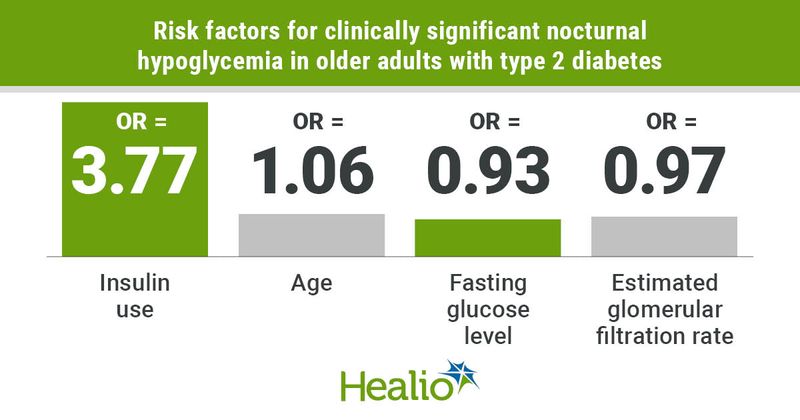Insulin use, older age raise risk for clinically significant nocturnal hypoglycemia
Insulin use, older age, lower fasting glucose and lower estimated glomerular filtration rate are associated with increased odds for clinically significant nocturnal hypoglycemia in older adults with type 2 diabetes, according to study data.
“In this study, we investigated multiple risk factors for clinically significant nocturnal hypoglycemia in geriatric patients with type 2 diabetes aged 65 years and evaluated their overall association with clinically significant nocturnal hypoglycemia using a multivariate logistic regression analysis,” Ken Kanazawa, MD, of the departments of diabetes, metabolism and endocrinology at Tokyo Rosai Hospital, and colleagues wrote in a study published in The Journal of Diabetes and Its Complications. “Age, fasting glucose level, insulin use and eGFR were identified as independent risk factors for clinically significant nocturnal hypoglycemia from this analysis. The impact of insulin use on clinically significant nocturnal hypoglycemia remains significant. In addition, fasting glucose level alone demonstrated a high predictability, and the role of continuous glucose monitoring appears to be very limited.”

Researchers conducted a case-control retrospective observational study in 606 adults aged 65 years and older with type 2 diabetes from October 2018 to February 2020. Clinically significant nocturnal hypoglycemia was defined as a blood glucose level of less than 54 mg/dL between midnight and 6 a.m. Participants wore a Freestyle Libre Pro (Abbott) CGM for 14 days. Those in the top quartile for highest frequency of clinically significant nocturnal hypoglycemia were placed in a nocturnal hypoglycemia group (n = 152) and those in the lowest quartile were placed in a non-nocturnal hypoglycemia group.
The clinically significant nocturnal hypoglycemia group had a lower mean glucose level between midnight and 6 a.m. (88.09 mg/dL vs. 114.86 mg/dL; P < .0001), higher time below range (13.66% vs. 1.04%; P < .0001) and lower time in range (76.98% vs. 82.63%; P = .0002) than the non-nocturnal hypoglycemia group. In multivariate logistic analysis, insulin use (OR = 3.77; 95% CI, 1.92-7.67; P < .0001), age (OR = 1.06; 95% CI, 1-1.12; P = .049), fasting glucose (OR = 0.93; 95% CI, 0.91-0.94; P < .0001) and eGFR (OR = 0.97; 95% CI, 0.95-0.98; P = .0004) were independently associated with clinically significant nocturnal hypoglycemia.
Cutoff values for predicting clinically significantly nocturnal hypoglycemia differed by insulin use. For adults using insulin, the odds for clinically significant nocturnal hypoglycemia increased with an FBG of less than 91 mg/dL, an eGFR of less than 41.2 mL/min/1.73 m2 and age older than 69 years. For adults who did not use insulin, the likelihood for clinically significant nocturnal hypoglycemia climbed with an FBG of less than 92 mg/dL, an eGFR of less than 70.93 mL/min/1.73 m2 and age older than 79 years.
“Our findings may help clarify the centralized clinical picture of clinically significant nocturnal hypoglycemia in geriatric patients with type 2 diabetes and serve as reference data to develop appropriate therapeutic approaches to minimize the hypoglycemia risk in these patients,” the researchers wrote. “Additionally, better glycemic control and prevention of complications, including fatalities, due to nocturnal hypoglycemia will help prevent the onset or progression of microvascular complications and prolong patients’ life.”
